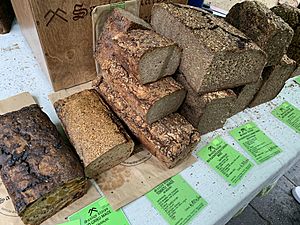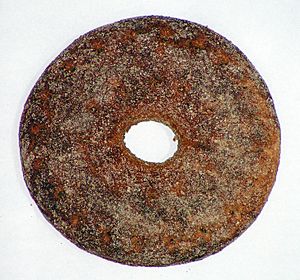Rye bread facts for kids

Different kinds of rye bread
|
|
| Type | Bread |
|---|---|
| Region or state | Europe, North America, Israel |
| Main ingredients | Rye flour |
Rye bread is a special kind of bread. It is made using flour from rye grain. The color of rye bread can be light or dark. This depends on the type of flour used. Sometimes, coloring is added too. Rye bread is usually thicker and heavier than bread made from wheat flour. It has more fiber than white bread. It also has a darker color and a stronger taste.
Rye bread was a very important food during the Middle Ages. Many types of rye grain come from countries in Europe. These include Germany, Denmark, Sweden, and Russia. Around 500 AD, a group called the Saxons came to Britain. They brought rye with them. Rye grew well in Britain's mild weather.
Contents
How Rye Bread Is Different
Rye and wheat are similar plants. But they act differently when making bread. The main difference is in their enzymes. Enzymes are like tiny helpers. They break down starch into sugar. In wheat, these helpers usually stop working when it gets hot. This is good because wheat has strong gluten. Gluten is what makes wheat bread stretchy and helps it rise.
Rye's enzymes keep working even when it's hot. Rye also has weaker gluten. So, if the enzymes break down too much starch, the rye dough can't rise well. It might become flat.
There are two main ways to fix this problem.
Using Sourdough
One way is to make the dough more acidic. This slows down the rye enzymes. But normal baker's yeast doesn't like acidic dough. So, bakers use a special mix called "sourdough". Sourdough contains good bacteria and a different kind of yeast. These like acidic conditions. Sourdough helps the bread rise. It also makes the bread lighter and adds a special taste.
Adding Wheat Flour
Another way is to add a lot of strong wheat flour to the rye flour. The wheat flour has strong gluten. This gluten helps the dough hold its shape. It makes up for the rye enzymes' activity. This method is common in places where strong wheat is easy to find. For example, "deli rye" bread in the United States often mixes rye and wheat. This also allows for breads with more than one grain. An old American recipe called "rye and Indian" bread mixed rye, wheat, and cornmeal.
Types of Rye Bread
Pure rye bread is made only with rye flour. It has no wheat. A famous example is German pumpernickel. This bread is very dark and thick. It is made from crushed rye grains. It is baked for a long time at a low heat.
Often, rye and wheat flours are mixed. This makes a rye bread that is lighter in color and texture. It also has a milder taste. Rye flour can be "light" or "dark." This depends on how much bran is left in the flour. Bakers often add caramel or molasses for color. They also add caraway seeds for flavor. In the United States, "rye" bread usually has caraway seeds. If it doesn't, it's called "unseeded." Some rye breads have other spices. These can include fennel, coriander, or citrus peel.
All-Rye Bread

A simple bread made only from rye is often called black bread. It uses a sourdough starter. This bread does not rise as high as wheat bread. But it is moister and stays fresh much longer. Its dark color comes from the rye and long baking times.
A good example is German Vollkornbrot. This bread has both rye flour and whole rye grains. It is used for sandwiches or with smoked fish. Danish rugbrød is another example. It is usually made with sourdough and rye. Seeds like pumpkin or poppy are sometimes added. Rugbrød is a common lunch food. People eat it with fish, meats, or cheese.
All-rye bread can last for months. This makes it good for long trips. It is often sliced very thinly because it is so dense.
Mixed Grain Rye Bread
Rye is often mixed with other grains and seeds. In Germany and Switzerland, some Vollkornbrot has sunflower seeds instead of rye seeds. Some old recipes use whole wheat grains.
In early North America, people mixed rye and cornmeal. This was called "rye and Indian" bread. If wheat flour was added, it was called "thirded" bread. These breads were heavier than wheat-only breads. But they were less dense than pure rye bread.
In medieval Europe, a bread called "maslin" was popular. It was a mix of rye and wheat. This was the bread for many peasants. Rich people ate white bread. Poorer peasants ate "horsebread." This was made from cheaper grains like oats or barley.
Flatbreads

There are different kinds of rye crispbread. Some use yeast, some use sourdough. Others are baked without any leavening. This last type is called "cold bread crispbread." It is like a very hard cracker. It is known as knäckebröd in Sweden.
Crispbread lasts a long time. This is because it has very little water. One of the biggest makers of rye flatbreads is the Swedish company Wasabröd.
Quick Breads
Rye flour is also used in "quick bread" recipes. These breads use baking soda or powder to rise. They don't need yeast. An example is Irish soda bread. In these breads, eggs often help give the bread its structure.
Jewish Rye Bread
Rye bread mixed with wheat flour is very popular in Jewish cuisine. This includes light rye and American pumpernickel. Often, these breads are made with sourdough. Sometimes, a little citric acid or vinegar is added. This helps make the dough acidic.
Jewish rye bread often has whole caraway seeds. It is usually brushed with an egg wash. This bread is often eaten with salted meats. These include corned beef and pastrami.
In the United States, Jewish-style American rye bread is sometimes called corn rye. This might come from the Yiddish word korn, meaning 'grain'. Or it could be from using cornmeal on the bread.
Similar breads are made in Scandinavia. Some, like Swedish Vörtlimpa, have sweeteners or citrus peel. They might also have spices like anise or cardamom. These are sometimes saved for special holidays.
Jewish Rye in Israel
Rye bread is very popular in Israel. Many people there have Ashkenazi Jewish family roots. It is the most common type of packaged bread in Israel. You can find it in schools, military bases, and stores. The mass-produced version is often soft. Many bakeries in cities like Tel Aviv and Jerusalem make their own versions. Some are new twists, while others are more traditional.
Jewish Rye in Canada
In Canada, you can find different types of Jewish rye bread. There are big brands like Oroweat. In cities with many Jewish people, like Montreal and Toronto, you can find real Ashkenazi Jewish-style rye bread. These are sold in bakeries, delis, and grocery stores.
There is also Winnipeg-style rye bread. This bread does not have much rye flour. Instead, it uses cracked rye or coarse rye meal mixed with wheat flour. Winnipeg-style rye bread does not have caraway seeds.
Nutrition
| Nutritional value per 100 g (3.5 oz) | |
|---|---|
| Energy | 259 kcal (1,080 kJ) |
|
48.30 g
|
|
| Sugars | 3.85 |
| Dietary fiber | 5.8 g |
|
3.30 g
|
|
|
Protein
|
8.50 g
|
| Vitamins | Quantity
%DV†
|
| Vitamin A | 7 IU |
| Thiamine (B1) |
38%
0.434 mg |
| Riboflavin (B2) |
28%
0.335 mg |
| Niacin (B3) |
24%
3.805 mg |
| Vitamin B6 |
6%
0.075 mg |
| Vitamin C |
0%
0.4 mg |
| Vitamin D |
0%
0 IU |
| Vitamin E |
2%
0.33 mg |
| Vitamin K |
1%
1.2 μg |
| Minerals | Quantity
%DV†
|
| Calcium |
7%
73 mg |
| Iron |
22%
2.83 mg |
| Magnesium |
11%
40 mg |
| Phosphorus |
18%
125 mg |
| Potassium |
6%
166 mg |
| Sodium |
40%
603 mg |
| Zinc |
12%
1.14 mg |
| Other constituents | Quantity |
| Water | 37.30 g |
|
Link to Full Nutrient Report of USDA Database entry
|
|
| †Percentages estimated using US recommendations for adults. | |
See also
 In Spanish: Pan de centeno para niños
In Spanish: Pan de centeno para niños


